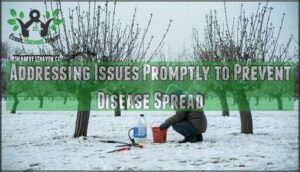This site is supported by our readers. We may earn a commission, at no cost to you, if you purchase through links.

Start by clearing fallen fruit and leaves—they’re like welcome mats for pests and diseases. Mulch around your trees to insulate roots, but keep it away from trunks to prevent rot.
Paint trunks white to prevent sun scald, which can crack bark during temperature swings. Water deeply before ground freezes, giving trees a drink for the long winter ahead.
Prune lightly, removing only dead or diseased branches—save major cuts for dormant season. These simple steps transform winter from your trees’ worst enemy into their quiet recovery period, making it a time for insulation and prevention of diseases.
Table Of Contents
- Key Takeaways
- Winter Fruit Tree Preparation
- Pruning Fruit Trees
- Watering Fruit Trees
- Maintaining Tree Health
- Frequently Asked Questions (FAQs)
- How do you take care of fruit trees in the winter?
- Which fruit tree can survive winter?
- Do you water fruit trees in the winter?
- Should you prune fruit trees in winter?
- How do you treat a fruit tree in winter?
- How to care for fruit trees in your garden?
- How can I prevent diseases and infestations in my fruit trees in winter?
- How do you care for a fruit tree in the fall?
- What should I spray my fruit trees with in winter?
- Do you prune fruit trees in winter?
- Conclusion
Key Takeaways
- Clear debris and apply mulch – Remove fallen fruit and leaves that harbor pests, then mulch around trees for root insulation, while keeping it away from trunks to prevent rot.
- Protect trunks from sun scald – Paint tree trunks with a 50% white latex paint mixture to prevent bark cracking from temperature swings during winter’s bright, reflective conditions.
- Water deeply before freeze – Give trees a thorough drink before the ground freezes to prevent dehydration stress during dormancy, using soaker hoses for efficient root zone watering.
- Prune strategically during dormancy – Remove only dead or diseased branches between December and February, saving major cuts for the dormant season to minimize disease exposure and promote healthy spring growth.
Winter Fruit Tree Preparation
Winter preparation protects your fruit trees from harsh weather while setting them up for robust spring growth.
You’ll need to focus on three key areas: clearing debris that harbors pests, mulching to insulate roots, and preventing sun scald damage to trunks.
Removing Debris and Infected Fruit
After summer’s end, thorough autumn cleanup prevents diseases from overwintering in your orchard.
Remove all fallen fruit, infected limbs, and leaf debris that harbor pests and pathogens.
- Fruit Disposal: Clear rotting apples, pears, and stone fruits from ground
- Debris Removal: Rake fallen leaves that shelter insect pests
- Infected Limbs: Cut diseased branches during dormant season pruning
This orchard sanitation creates a clean foundation for winter fruit tree care and effective disease prevention.
Proper fruit tree protection methods are essential for maintaining healthy trees during harsh winter conditions.
Insulating Root Systems With Mulch
After removing debris, you’ll want to protect your tree’s root system with proper mulch.
Apply a 2-4 inch layer of bark mulch, straw, or wood chips around the tree base for winter insulation.
This mulch provides vital root protection by maintaining stable soil temperature and moisture levels.
Your feeder roots stay insulated from freezing temperatures, ensuring healthy soil conditions for spring growth and effective tree root system care.
Using the right bark mulch products is essential for effective root insulation and tree health.
Protecting Tree Trunks From Sun Scald
Winter sun creates a deceiving enemy for fruit trees. Bright sunlight reflecting off snow heats bark during the day, then freezing nighttime temperatures cause damaging cracks.
Winter’s false warmth lures trees into vulnerability, setting them up for frostbite’s cruel surprise.
Protect your trees with these proven methods:
- Paint trunks with 50% white latex paint and 50% water mixture
- Wrap young trees with spiral vinyl guards or kitchen foil
- Remove protection in early spring to prevent insect breeding
This trunk protection prevents sun scald and costly bark damage, which is a critical aspect of maintaining healthy fruit trees, and ultimately helps in preventing damaging cracks.
Pruning Fruit Trees
Winter pruning shapes your fruit trees for ideal health and productivity while they’re dormant and less vulnerable to stress.
You’ll want to prune between December and early February for most deciduous trees, focusing on removing diseased wood, improving air circulation, and encouraging strong growth patterns.
Pruning Deciduous and Evergreen Trees
During dormant periods, you’ll handle deciduous and evergreen trees differently, as each requires specific winter tree pruning techniques. Deciduous trees enter complete dormancy, making dormant pruning ideal between December and February when sap flow stops. Evergreens maintain some activity, requiring gentler pruning techniques just before spring growth begins.
| Tree Type | Pruning Timing | Key Considerations |
|---|---|---|
| Deciduous | December-February | Complete dormancy allows heavy pruning |
| Evergreen | Late winter/early spring | Light pruning before new growth |
| Apricot family | August only | Prevents Eutypa infection |
| Stone fruits | Late winter | Minimal cuts on peaches |
| Citrus | Year-round | Summer oil treatments preferred |
Your pruning tools should include bypass pruners for clean cuts and loppers for medium branches. Understanding tree anatomy helps you make proper cuts just above outward-facing buds. Branch cutting technique matters—angle cuts promote healing while preventing water collection that leads to rot. Proper use of bypass pruning tools is essential for maintaining healthy trees and preventing Eutypa infection with minimal cuts.
Pruning for Air Circulation and Sunlight
Proper pruning techniques create an open canopy that allows air circulation and sunlight penetration throughout your fruit trees.
Branch thinning removes crowded growth while tree shaping maintains ideal structure for light distribution.
These winter pruning methods reduce disease risk and improve fruit quality by ensuring adequate airflow around branches and leaves.
- Remove inward-growing branches that block sunlight from reaching interior fruiting wood
- Thin overcrowded areas to create spacing between branches for better air movement
- Maintain an open center or central leader shape to maximize light interception
- Prune crossing branches that create dense, poorly ventilated areas in the canopy
Removing Dead or Diseased Branches
During tree inspection, identify diseased wood by looking for discolored, cracked, or fungal-infected areas.
Sterilize pruning tools with denatured alcohol before deadwood cutting to prevent disease spread. Cut diseased branches back to healthy wood at the next branch junction, removing all infected material.
This dormant tree care prevents tree disease prevention issues from spreading throughout your orchard.
Proper pruning techniques, including fruit tree pruning, are essential for maintaining healthy trees and boosting fruit production.
Watering Fruit Trees
You’ll need to maintain proper hydration for your fruit trees even during winter months, as dry spells can stress root systems and compromise spring growth.
Deep watering every few weeks on warmer days guarantees trees stay healthy through dormancy and emerge strong when growing season returns, which is crucial for healthy trees.
Deep Watering Before Ground Freezes
Give your fruit trees a final drink before winter’s grip sets in, as deep watering guarantees soil moisture reaches the root zone before freezing temperatures arrive.
This vital winter hydration prevents dehydration stress during dormancy, while proper soil moisture levels support root insulation and freeze protection, avoiding water logging that damages vulnerable root systems.
Proper fruit tree protection methods are essential for maintaining healthy trees during the cold season, ensuring deep watering and proper soil moisture levels are key to preventing damage and supporting root insulation.
Using Soaker Hoses for Effective Watering
Soaker hoses deliver water directly to root zones, making them perfect for winter hydration needs.
These efficient irrigation systems prevent water waste while ensuring deep watering reaches where it’s needed most.
Position your soaker hose in a circle around the tree’s drip line, maintaining consistent soil moisture without creating soggy conditions that can damage roots during freezing temperatures.
Understanding proper soaker hose systems is essential for effective tree care.
Adjusting Watering Based on Weather Conditions
Weather patterns directly impact your watering schedule throughout winter months.
Monitor rainfall amounts and check soil moisture levels regularly to avoid overwatering during wet periods.
During drought conditions, increase deep watering frequency while conserving water through efficient irrigation methods.
Adjust timing based on frost protection needs, as moist soil retains heat better than dry ground, helping prevent root damage during temperature drops, using deep watering and considering frost protection.
Maintaining Tree Health
Winter care extends beyond basic maintenance to address the unique challenges your fruit trees face during dormancy.
Proactive health management now prevents costly problems and guarantees vigorous growth when spring arrives.
Storing Potted Fruit Trees in Protected Spots
Several winter protection techniques can safeguard your potted fruit trees from harsh conditions.
Move containers to protected locations like unheated garages, sheds, or against south-facing walls where they’ll receive shelter from wind and extreme temperatures.
Cold framing provides excellent pot protection by creating a microclimate around your trees, and these frost protection strategies prevent root damage that kills more potted plants than cold air temperatures alone.
Insulating Pots With Mulch and Burlap
Beyond storing potted fruit trees in protected areas, proper pot insulation creates an extra barrier against freezing temperatures that can damage roots.
Effective winter guarding for potted trees requires strategic layering:
- Mulch Benefits: Apply 4-6 inches of bark mulch around the pot’s base for root protection
- Burlap Wrapping: Wrap the entire container with burlap, securing it with twine
- Pot Insulation: Add bubble wrap or foam boards between burlap and pot for enhanced frost protection strategies
This winter fruit tree care approach prevents soil from freezing solid while maintaining proper drainage throughout cold months.
Understanding frost damage types is essential for implementing effective protection methods for potted fruit trees.
Addressing Issues Promptly to Prevent Disease Spread
Quick detection and response save your orchard from disaster.
Early action prevents orchard catastrophe.
Regular winter inspections catch problems early, reducing disease outbreaks by 60%.
When you spot infected bark, cankers, or unusual growth, act immediately.
Remove affected branches, sterilize your tools between cuts, and apply appropriate treatments.
This proactive approach to disease prevention and pest control strengthens your trees’ natural disease resistance, ensuring healthier harvests ahead, through regular winter inspections and immediate action to prevent disease outbreaks.
Frequently Asked Questions (FAQs)
How do you take care of fruit trees in the winter?
Like a dormant guardian awaiting spring’s call, you’ll protect your trees through winter’s harsh embrace.
Prune diseased branches, apply dormant oil sprays, wrap trunks against sunscald, mulch roots, and remove fallen leaves to prevent pest infestations and ensure the health of your trees, which is crucial for their survival.
Which fruit tree can survive winter?
Most deciduous fruit trees handle winter well when properly cared for.
Apple trees tolerate cold best, surviving temperatures down to -40°F, while peach and cherry trees need protection below 0°F for ideal survival.
Do you water fruit trees in the winter?
Yes, you should water fruit trees during winter, especially during dry spells.
Deep watering every few weeks on warmer days keeps roots healthy.
Use soaker hoses or drip irrigation to avoid waterlogging.
Should you prune fruit trees in winter?
You should prune most fruit trees during winter dormancy, typically December through early February. This timing minimizes disease exposure while trees aren’t actively growing, promoting healthier spring growth.
How do you treat a fruit tree in winter?
Apply dormant oil sprays before buds swell, prune during dormancy, protect trunks with white paint to prevent sunscald, and wrap young trees against rodent damage.
How to care for fruit trees in your garden?
Like a tree’s roots reaching deep for winter sustenance, your fruit trees need strategic care year-round.
You’ll prune during dormancy, apply mulch for root protection, and use dormant sprays to prevent pests and diseases.
How can I prevent diseases and infestations in my fruit trees in winter?
Clean up fallen leaves and rotting fruit thoroughly, as they harbor pests and diseases. Prune diseased branches during dormancy, sterilize tools, and apply dormant oil sprays before buds swell.
How do you care for a fruit tree in the fall?
Fall’s the perfect time to tackle cleanup and prep work that’ll set your trees up for winter success.
Remove all fallen fruit and leaves, rake thoroughly, and apply mulch around the base to protect those precious feeder roots from freezing temperatures.
What should I spray my fruit trees with in winter?
Proper winter spraying can increase fruit tree health by 80%, making it essential for orchard success.
You’ll want to apply dormant oil sprays to apples, plums, and pears for leaf curl control, while using copper fungicide on peach and nectarine trees to prevent disease spread effectively, which is crucial for disease control.
Do you prune fruit trees in winter?
Yes, you should prune fruit trees during winter dormancy, typically December through early February.
This timing minimizes disease exposure and promotes healthy spring growth.
However, prune apricot family trees in August to prevent Eutypa infection.
Conclusion
Picture your fruit trees standing tall against winter’s harsh backdrop, their branches reaching skyward like grateful arms after months of your careful attention.
Proper winter fruit tree care transforms these vulnerable months into a foundation for next year’s abundant harvest.
You’ve protected their roots with mulch, painted their trunks white against sun scald, and pruned away disease.
Now they’ll rest peacefully, conserving energy for spring’s explosive growth.
Your proactive approach guarantees healthy, productive trees that’ll reward your efforts with bountiful fruit for years to come, ensuring a bountiful harvest.
- https://www.starkbros.com/growing-guide/article/winter-protection-fruit-trees
- https://www.canr.msu.edu/news/late-winter-pruning-of-fruit
- https://www.arborday.org/perspectives/winter-tree-watering-tips
- https://orchardpeople.com/when-to-stop-watering-fruit-trees/
- https://gregalder.com/yardposts/how-much-to-water-a-fruit-tree-in-southern-california-roughly/










